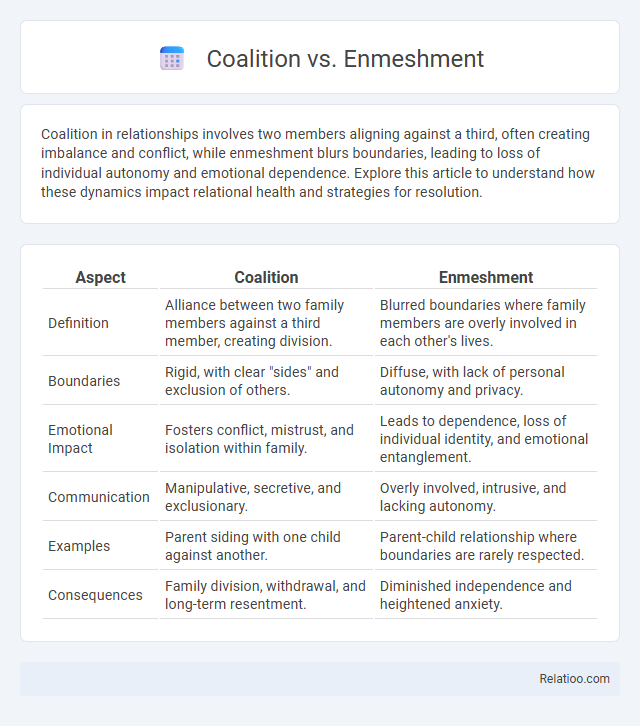Coalition in relationships involves two members aligning against a third, often creating imbalance and conflict, while enmeshment blurs boundaries, leading to loss of individual autonomy and emotional dependence. Explore this article to understand how these dynamics impact relational health and strategies for resolution.
Table of Comparison
| Aspect | Coalition | Enmeshment |
|---|---|---|
| Definition | Alliance between two family members against a third member, creating division. | Blurred boundaries where family members are overly involved in each other's lives. |
| Boundaries | Rigid, with clear "sides" and exclusion of others. | Diffuse, with lack of personal autonomy and privacy. |
| Emotional Impact | Fosters conflict, mistrust, and isolation within family. | Leads to dependence, loss of individual identity, and emotional entanglement. |
| Communication | Manipulative, secretive, and exclusionary. | Overly involved, intrusive, and lacking autonomy. |
| Examples | Parent siding with one child against another. | Parent-child relationship where boundaries are rarely respected. |
| Consequences | Family division, withdrawal, and long-term resentment. | Diminished independence and heightened anxiety. |
Defining Coalition and Enmeshment
Coalition occurs when two parties form an alliance against a third, creating an imbalanced relational dynamic that often excludes or marginalizes the third member. Enmeshment describes a lack of boundaries between individuals in a relationship, resulting in over-involvement and blurred personal identities. Understanding the distinction helps you recognize unhealthy patterns and promote balanced, respectful connections.
Key Differences Between Coalition and Enmeshment
Coalition involves an alliance between two family members against a third, creating a temporary power imbalance, while enmeshment describes overly blurred boundaries where individuality is lost and roles are confused. Your awareness of these dynamics helps identify whether relationships function through strategic alignment or merged identities, with coalition highlighting conflict-driven partnerships and enmeshment emphasizing emotional entanglement. Recognizing these distinctions improves family therapy outcomes by targeting either boundary-setting or conflict resolution.
Psychological Foundations of Coalition
Coalition in psychology refers to an alliance formed between two individuals within a group, often creating imbalance by excluding others, which contrasts with enmeshment where boundaries are blurred and individual identities are merged. Psychological foundations of coalition emphasize the impact on family dynamics and emotional development, highlighting how coalitions can lead to loyalty conflicts and hinder healthy communication. Your awareness of these dynamics can help in recognizing dysfunctional patterns and fostering healthier relational boundaries.
Psychological Foundations of Enmeshment
Enmeshment involves blurred boundaries within family systems, where individual autonomy is compromised due to excessive emotional involvement and dependency, often stemming from unmet developmental needs and maladaptive attachment patterns. Psychological foundations of enmeshment include impaired differentiation of self, leading to difficulties in emotional regulation and identity formation, which contrasts with coalitions that are temporary alliances between family members against another, disrupting systemic balance. Your awareness of these distinctions is crucial for fostering healthy interpersonal dynamics and promoting psychological resilience within relational contexts.
Family Dynamics: Coalition vs Enmeshment
In family dynamics, coalition describes an alliance where two members unite against a third, often disrupting healthy boundaries and causing tension. Enmeshment occurs when family roles and emotions are overly intertwined, leading to blurred personal boundaries and diminished individuality. Understanding these patterns helps you recognize unhealthy relationships and promotes healthier family interactions.
Signs and Symptoms of Coalition Relationships
Coalition relationships often involve two individuals aligning against a third, marked by signs such as exclusivity, secrecy, and persistent conflict triads that disrupt family dynamics. Symptoms include increased tension, feelings of betrayal, and emotional distress in the excluded member, with communication breakdowns and loyalty conflicts frequently observed. Enmeshment contrasts by showing blurred boundaries and over-involvement, but coalition specifically manifests through alliance patterns that pit family members against one another.
Indicators of Enmeshment in Families
Enmeshment in families is indicated by blurred personal boundaries, where individual autonomy is compromised and family members are overly involved in each other's lives. You may notice excessive emotional dependence, lack of privacy, and difficulty distinguishing personal feelings from those of other family members. These signs of enmeshment often result in impaired individual identity and hinder healthy family functioning.
Impact on Individual Mental Health
Coalition in family dynamics often fosters a sense of alliance that can both support and pressure individuals, potentially leading to feelings of exclusion or loyalty conflicts impacting mental health. Enmeshment blurs personal boundaries, resulting in reduced autonomy and increased anxiety or stress due to an overwhelming emotional dependency. Healthy differentiation requires clear boundaries, enabling individuals to maintain identity and emotional well-being without the negative impacts associated with coalition or enmeshment.
Therapeutic Approaches for Coalition and Enmeshment
Therapeutic approaches for coalition focus on realigning family alliances by fostering open communication and promoting individual boundaries to reduce covert conflicts. Treatment for enmeshment emphasizes establishing healthy differentiation through boundary setting, helping family members develop autonomy while maintaining emotional connections. Both approaches utilize family therapy techniques such as structural family therapy and boundary-setting interventions to restore functional relationships and emotional balance.
Building Healthy Family Boundaries
Building healthy family boundaries requires understanding the differences between coalition, enmeshment, and healthy alliances. Coalitions involve unhealthy alliances where one family member aligns with another against a third, creating imbalance and tension. You can promote emotional well-being by fostering clear boundaries that prevent enmeshment, which blurs individual roles and limits autonomy within family relationships.

Infographic: Coalition vs Enmeshment
 relatioo.com
relatioo.com